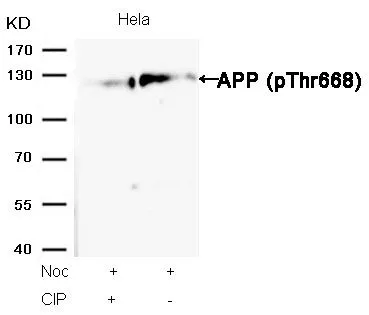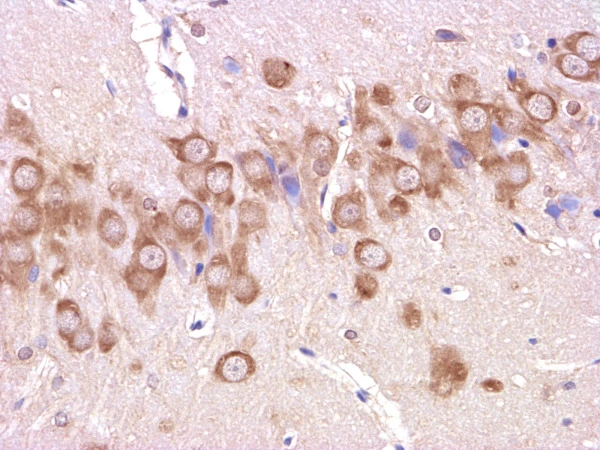![ICC/IF analysis of HeLa cells using GTX84877 APP antibody [2B10]. ICC/IF analysis of HeLa cells using GTX84877 APP antibody [2B10].](https://www.genetex.com/upload/website/prouct_img/normal/GTX84877/GTX84877_1271_ICCIF_w_23061420_347.webp)
ICC/IF analysis of HeLa cells using GTX84877 APP antibody [2B10].
APP antibody [2B10]
GTX84877
ApplicationsImmunoFluorescence, Western Blot, ImmunoCytoChemistry, ImmunoHistoChemistry, ImmunoHistoChemistry Paraffin
Product group Antibodies
ReactivityHuman
TargetAPP
Overview
- SupplierGeneTex
- Product NameAPP antibody [2B10]
- Delivery Days Customer9
- Application Supplier NoteWB: 1:2000. ICC/IF: 1:50. IHC-P: 1:50. *Optimal dilutions/concentrations should be determined by the researcher.Not tested in other applications.
- ApplicationsImmunoFluorescence, Western Blot, ImmunoCytoChemistry, ImmunoHistoChemistry, ImmunoHistoChemistry Paraffin
- CertificationResearch Use Only
- ClonalityMonoclonal
- Clone ID2B10
- Concentration0.74 mg/ml
- ConjugateUnconjugated
- Gene ID351
- Target nameAPP
- Target descriptionamyloid beta precursor protein
- Target synonymsAAA, ABETA, ABPP, AD1, APPI, CTFgamma, CVAP, PN-II, PN2, alpha-sAPP, preA4, amyloid-beta precursor protein, alzheimer disease amyloid A4 protein homolog, alzheimer disease amyloid protein, amyloid beta (A4) precursor protein, amyloid beta A4 protein, amyloid precursor protein, beta-amyloid peptide, beta-amyloid peptide(1-40), beta-amyloid peptide(1-42), beta-amyloid precursor protein, cerebral vascular amyloid peptide, peptidase nexin-II, protease nexin-II, testicular tissue protein Li 2
- HostMouse
- IsotypeIgG1
- Protein IDP05067
- Protein NameAmyloid-beta precursor protein
- Scientific DescriptionFunctions as a cell surface receptor and performs physiological functions on the surface of neurons relevant to neurite growth, neuronal adhesion and axonogenesis. Involved in cell mobility and transcription regulation through protein-protein interactions. Can promote transcription activation through binding to APBB1-KAT5 and inhibits Notch signaling through interaction with Numb. Couples to apoptosis-inducing pathways such as those mediated by G(O) and JIP. Inhibits G(o) alpha ATPase activity (By similarity). Acts as a kinesin I membrane receptor, mediating the axonal transport of beta-secretase and presenilin 1. Involved in copper homeostasis/oxidative stress through copper ion reduction. In vitro, copper-metallated APP induces neuronal death directly or is potentiated through Cu(2+)-mediated low-density lipoprotein oxidation. Can regulate neurite outgrowth through binding to components of the extracellular matrix such as heparin and collagen I and IV. The splice isoforms that contain the BPTI domain possess protease inhibitor activity. Induces a AGER-dependent pathway that involves activation of p38 MAPK, resulting in internalization of amyloid-beta peptide and leading to mitochondrial dysfunction in cultured cortical neurons. Beta-amyloid peptides are lipophilic metal chelators with metal-reducing activity. Bind transient metals such as copper, zinc and iron. In vitro, can reduce Cu(2+) and Fe(3+) to Cu(+) and Fe(2+), respectively. Beta-amyloid 42 is a more effective reductant than beta-amyloid 40. Beta-amyloid peptides bind to lipoproteins and apolipoproteins E and J in the CSF and to HDL particles in plasma, inhibiting metal-catalyzed oxidation of lipoproteins. Beta-APP42 may activate mononuclear phagocytes in the brain and elicit inflammatory responses. Promotes both tau aggregation and TPK II-mediated phosphorylation. Interaction with overexpressed HADH2 leads to oxidative stress and neurotoxicity. Appicans elicit adhesion of neural cells to the extracellular matrix and may regulate neurite outgrowth in the brain. The gamma-CTF peptides as well as the caspase-cleaved peptides, including C31, are potent enhancers of neuronal apoptosis. N-APP binds TNFRSF21 triggering caspase activation and degeneration of both neuronal cell bodies (via caspase-3) and axons (via caspase-6).
- ReactivityHuman
- Storage Instruction-20°C or -80°C,2°C to 8°C
- UNSPSC12352203

![ICC/IF analysis of HT29 cells using GTX84877 APP antibody [2B10]. ICC/IF analysis of HT29 cells using GTX84877 APP antibody [2B10].](https://www.genetex.com/upload/website/prouct_img/normal/GTX84877/GTX84877_1272_ICCIF_w_23061420_360.webp)
![IHC-P analysis of human liver carcinoma tissue using GTX84877 APP antibody [2B10]. Antigen retrieval : Heat-induced epitope retrieval by 10mM citrate buffer, pH6.0, 100oC for 10min. IHC-P analysis of human liver carcinoma tissue using GTX84877 APP antibody [2B10]. Antigen retrieval : Heat-induced epitope retrieval by 10mM citrate buffer, pH6.0, 100oC for 10min.](https://www.genetex.com/upload/website/prouct_img/normal/GTX84877/GTX84877_3200_IHC-P_w_23061420_765.webp)
![IHC-P analysis of human bladder tissue using GTX84877 APP antibody [2B10]. Antigen retrieval : Heat-induced epitope retrieval by 10mM citrate buffer, pH6.0, 100oC for 10min. IHC-P analysis of human bladder tissue using GTX84877 APP antibody [2B10]. Antigen retrieval : Heat-induced epitope retrieval by 10mM citrate buffer, pH6.0, 100oC for 10min.](https://www.genetex.com/upload/website/prouct_img/normal/GTX84877/GTX84877_3201_IHC-P_w_23061420_778.webp)
![IHC-P analysis of human colon tissue using GTX84877 APP antibody [2B10]. Antigen retrieval : Heat-induced epitope retrieval by 10mM citrate buffer, pH6.0, 100oC for 10min. IHC-P analysis of human colon tissue using GTX84877 APP antibody [2B10]. Antigen retrieval : Heat-induced epitope retrieval by 10mM citrate buffer, pH6.0, 100oC for 10min.](https://www.genetex.com/upload/website/prouct_img/normal/GTX84877/GTX84877_3202_IHC-P_w_23061420_313.webp)
![IHC-P analysis of human endometrium tissue using GTX84877 APP antibody [2B10]. Antigen retrieval : Heat-induced epitope retrieval by 10mM citrate buffer, pH6.0, 100oC for 10min. IHC-P analysis of human endometrium tissue using GTX84877 APP antibody [2B10]. Antigen retrieval : Heat-induced epitope retrieval by 10mM citrate buffer, pH6.0, 100oC for 10min.](https://www.genetex.com/upload/website/prouct_img/normal/GTX84877/GTX84877_3203_IHC-P_w_23061420_538.webp)
![IHC-P analysis of human kidney tissue using GTX84877 APP antibody [2B10]. Antigen retrieval : Heat-induced epitope retrieval by 10mM citrate buffer, pH6.0, 100oC for 10min. IHC-P analysis of human kidney tissue using GTX84877 APP antibody [2B10]. Antigen retrieval : Heat-induced epitope retrieval by 10mM citrate buffer, pH6.0, 100oC for 10min.](https://www.genetex.com/upload/website/prouct_img/normal/GTX84877/GTX84877_3204_IHC-P_w_23061420_635.webp)
![IHC-P analysis of human liver tissue using GTX84877 APP antibody [2B10]. Antigen retrieval : Heat-induced epitope retrieval by 10mM citrate buffer, pH6.0, 100oC for 10min. IHC-P analysis of human liver tissue using GTX84877 APP antibody [2B10]. Antigen retrieval : Heat-induced epitope retrieval by 10mM citrate buffer, pH6.0, 100oC for 10min.](https://www.genetex.com/upload/website/prouct_img/normal/GTX84877/GTX84877_3205_IHC-P_w_23061420_252.webp)
![IHC-P analysis of human lung tissue using GTX84877 APP antibody [2B10]. Antigen retrieval : Heat-induced epitope retrieval by 10mM citrate buffer, pH6.0, 100oC for 10min. IHC-P analysis of human lung tissue using GTX84877 APP antibody [2B10]. Antigen retrieval : Heat-induced epitope retrieval by 10mM citrate buffer, pH6.0, 100oC for 10min.](https://www.genetex.com/upload/website/prouct_img/normal/GTX84877/GTX84877_3206_IHC-P_w_23061420_137.webp)
![IHC-P analysis of human pancreas tissue using GTX84877 APP antibody [2B10]. Antigen retrieval : Heat-induced epitope retrieval by 10mM citrate buffer, pH6.0, 100oC for 10min. IHC-P analysis of human pancreas tissue using GTX84877 APP antibody [2B10]. Antigen retrieval : Heat-induced epitope retrieval by 10mM citrate buffer, pH6.0, 100oC for 10min.](https://www.genetex.com/upload/website/prouct_img/normal/GTX84877/GTX84877_3207_IHC-P_w_23061420_359.webp)




![ICC/IF analysis of COS7 cells transiently transfected with APP plasmid using GTX84873 APP antibody [4C3].](https://www.genetex.com/upload/website/prouct_img/normal/GTX84873/GTX84873_1270_ICCIF_w_23061420_163.webp)
